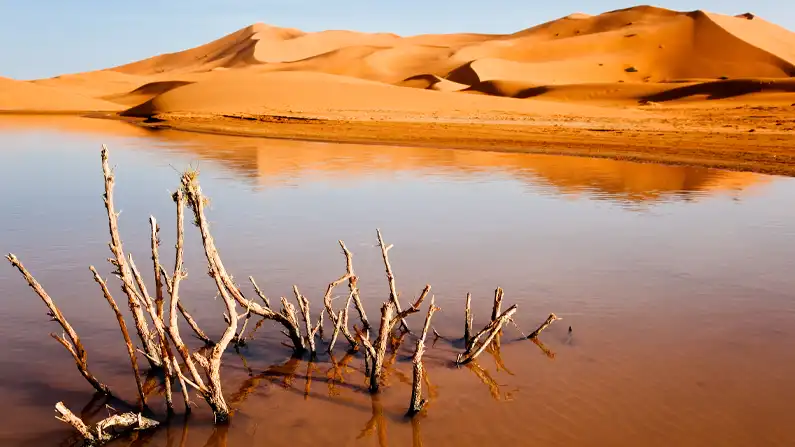Breadcrumbs
These links will help you get back to where you want to go faster.
Monsoon Season in Arizona
Be prepared for an exciting journey into the monsoon season
Monsoon season is a fascinating weather phenomenon that brings heavy rains and thunderstorms to our desert state. Believe us, we need it after months of dry summer heat; ask any Arizonan and they will agree.
What You Will Learn in this Study
- Science: How does a monsoon form? Why does it form in summer and not in winter?
- Causes / Effects: What is a monsoon’s impact on our environment, wildlife, agriculture, water conservation, etc.
- History: When did we start learning and studying monsoons?
Okay Arizona, buckle up (or tarp up – because we are roofers after all) because this monsoon season adventure is about to begin.

The Science of Monsoons
Monsoons are powerful weather patterns characterized by heavy rainfall, strong winds and thunderstorms. They form due to temperature differences between land and water. Monsoons are influenced by factors such as ocean temperatures, landmass configurations, and atmospheric circulation patterns.
The nearby Mexican Plateau heats up, creating a pressure gradient that draws in moist air from the Gulf of California. During summer, the sun heats up the land faster than the ocean, creating low-pressure areas over land. As a result, moisture-laden air from the ocean rushes in, causing those refreshing summer rains.

The Causes and Effects of Monsoons
In Arizona, the summer is brutal on roofs, buildings, vehicles, pavement and… well, everything! That is because the sun emits UV rays that over time deteriorate things like metal and plastic.
If you are heading into Monsoon Season (typically between May, June, July and August) you will want to prepare your home for the blast of weather headed your way.
What are the Causes and Effects of a Monsoon?
- Water: Monsoon heavy rainfall brings much needed water to dry areas. This replenishes water sources such as rivers, lakes and groundwater.
- Eco-System: Supports and creates new habitats for various species, such as amphibians, insects and reptiles.
- Food: Monsoons allow farmers to irrigate their fields and cultivate a variety of crops, contributing to food security for the region.
- Strong Winds: These invisible drafts are bringing in the new weather from the West Coast. Get prepared for monsoon winds by getting rid of tree branches and limbs that are hanging on your roof.
Monsoons are Amazing Weather Designs
They are crucial to keep Arizona alive and well. Monsoon rainfall is essential for the survival of plants, animals, and humans. It also helps to rejuvenate the soil, making it fertile and suitable for plant growth.
Creatures also thrive in the wet conditions and play important roles in maintaining the balance of the ecosystem. Additionally, the monsoon season also replenishes natural water sources, providing drinking water for wildlife and ensuring their survival.
Heavy rainfall during monsoon season helps refill reservoirs, lakes, and other water bodies that may have been depleted during dry periods. This ensures a steady supply of water for human consumption, agriculture, and industrial purposes.
Danger
Excessive rainfall during the monsoon season can lead to flooding, soil erosion, and other natural disasters. Your home is a valuable asset – keep it that way and protect your roof with emergency storm damage from Arizona Pristine Roofing. If your shingle, tile, flat or foam roof is leaking, you can request a free roof inspection by an insurance claim specialist and call: 623-257-ROOF (7663)
It’s crucial for communities and governments to be prepared and have proper infrastructure in place to mitigate these risks.

The History of Monsoons
Arizona monsoon season typically occurs from June to September. Its’ arrival and intensity can vary from year to year. Scientists and researchers are studying past monsoon cycles to gain insights into how natural climate change cycles affect their intensity and duration.
By analyzing climate records, tree rings, and other indicators, they can develop models to predict future monsoon behavior and its potential impact on water resources, ecosystems, and communities.
Monsoon’s have been with since, forever. No monsoon? No life! It really is that simple. Arizonan’s would be living in a blistering microwave, every day, all year long, if it weren’t for the amazing design of the Monsoon. The onset of the monsoon is often marked by a surge of moisture from the Gulf of California, resulting in thunderstorms, heavy rainfall, and dramatic lightning displays.
Over the years, humans have developed an weather alert system to stay informed about weather forecasts and be prepared for sudden changes in conditions. Flash floods, dust storms (known as haboobs), and lightning strikes are common occurrences during this time. By following safety guidelines and staying updated on weather alerts, you can enjoy the monsoon’s beauty while keeping yourself and others safe.
Monsoon Storm Damage
The Arizona Monsoon is a powerful force of nature that must be respected. By understanding its patterns and impacts, we can better prepare for its arrival and adapt to the natural changing climate cycles. So, next time you witness the dark clouds gathering and feel the cool breeze on your skin, take a moment to appreciate the science, effects and history of the Arizona Monsoon.




